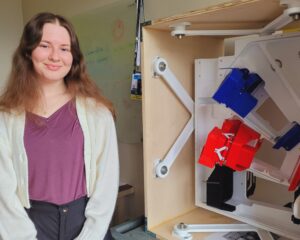
Amanda was born in Santa Cruz, CA, and grew up in Kailua-Kona, HI, where she graduated from Kealakehe High School in 2020. She currently attends the University of Portland, where she is majoring in mechanical engineering and minoring in computer science. Alongside her studies, Amanda actively contributes to her school community by serving at the helm of UP’s yearbook as Editor-in-Chief and as the Treasurer for her school’s Society of Women Engineers chapter. Amanda’s passions lie in the fields of aerospace and astronomical instrumentation, and she is particularly intrigued by topics that explore the intersection of visual arts, science, and engineering. In her free time, she enjoys running, finding cats in her neighborhood, and sipping on good coffee.
Home Island: Big Island of Hawai’i
High School: Kealakehe High School
Institution when accepted: University of Portland
Verification of the Assembly Plan for NASA IRTF’s SPECTRE Instrument
Project Site: NASA Infrared Telescope Facility, Hilo, HI
Mentors: Mike Connelley
Project Abstract:
The 3.2-meter NASA Infrared Telescope Facility (IRTF) is currently developing SPECTRE, a three-channel integral field spectrograph covering the wavelength range 0.4–4.2 µm. SPECTRE will allow for the efficient characterization of small solar system bodies and astrophysical transient objects. The instrument would also aid in assessing the impact potential of near-Earth objects, a key goal of NASA. A preliminary design of SPECTRE has been created, and the assembly plan for the instrument needs to be tested to ensure viability. It is important to vet the assembly plan because the alignment of the instrument’s internal optics will be an extensive and delicate process. Additionally, we need to test that key areas can be accessed since SPECTRE is more compact than previous facility instruments. To verify SPECTRE’s assembly plan, a full-scale mockup of the instrument was created using primarily 3D-printed components. Significant attention was placed on the instrument’s optics bench to address concerns regarding optical alignment. To ensure that real hardware could be used to practice the assembly procedure, we machined threaded inserts and installed heat-set inserts into clearance holes. Discrepancies such as part interferences, fastener accessibility issues, and optical alignment concerns were discovered and noted in a technical document to help inform the engineering team of potential mechanical design improvements and updates that need to be made to the assembly plan. The physical model aided in identifying logical inconsistencies in the assembly plan because prior to its existence, the plan was based on an intangible version of the design. This work was presented at the Preliminary Design Review (PDR) for SPECTRE, an important milestone in evaluating project readiness. The physical model was well-received by the review panel and instilled confidence in the maturity of SPECTRE’s mechanical design.